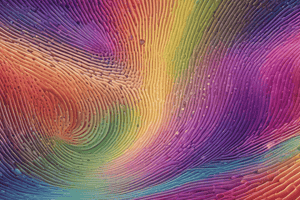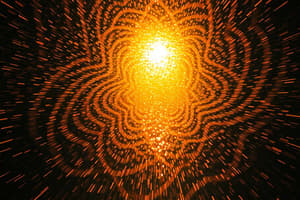Podcast
Questions and Answers
What is diffraction?
What is diffraction?
Diffraction is the process by which a beam of light is spread out as it passes through an aperture or across the edge of an object.
What is the condition for diffraction to occur?
What is the condition for diffraction to occur?
The aperture (or hole or slit) has to be comparable to the wavelength of the wave.
What happens when light passes through an aperture and diffracts?
What happens when light passes through an aperture and diffracts?
An interference pattern is produced.
What is an interference pattern for light?
What is an interference pattern for light?
What is constructive interference?
What is constructive interference?
What is destructive interference?
What is destructive interference?
What are the two types of interferences that can result from diffraction?
What are the two types of interferences that can result from diffraction?
What is diffraction?
What is diffraction?
What is an interference pattern?
What is an interference pattern?
What happens to the diffraction pattern when the aperture becomes smaller?
What happens to the diffraction pattern when the aperture becomes smaller?
What did the author observe in the lab with a single slit aperture?
What did the author observe in the lab with a single slit aperture?
What equipment was used in the lab experiment?
What equipment was used in the lab experiment?
How did the author adjust the laser pointer to change the aim?
How did the author adjust the laser pointer to change the aim?
What is the purpose of cutting the razor blade into two halves?
What is the purpose of cutting the razor blade into two halves?
What is the maximum width of the slit in the lab experiment?
What is the maximum width of the slit in the lab experiment?
Flashcards are hidden until you start studying



